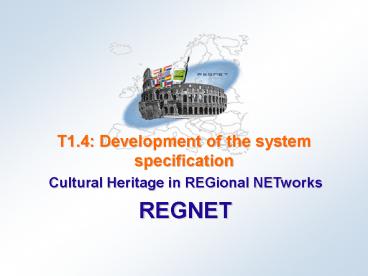T1.4: Development of the system specification - PowerPoint PPT Presentation
Title:
T1.4: Development of the system specification
Description:
Describe the sequence of events of an actor using a system to ... Don't replace CORBA, or DCOM, or RMI. A SOAP message is XML composed of: An optional header ... – PowerPoint PPT presentation
Number of Views:26
Avg rating:3.0/5.0
Title: T1.4: Development of the system specification
1
T1.4 Development of the system specification
2
Contents
- Process
- Regnet organisation
- Analysis
- Use case
- Functional architecture
- Technical architecture
- Requirements
- Technical architecture
- Web services, ebXML, Topic Map, Wap
3
Process
4
Architecture oriented process
Based on UML
5
Organisation
6
REGNET organisation
CIO
Portal
CSC
7
Building blocks
8
Components
9
REGNET organisation
10
ANALYSIS
11
Analysis
- Actors
- An actor in a use case is an external agent that
uses or interacts with the system. - Use Case
- Describe the sequence of events of an actor using
a system to complete a process. - Are a narrative description of a business
process. - Use case diagram
12
Actors
13
Use Case diagram (example)
14
Functional Architecture
15
Technical Architecture
16
Main technical requirements
- Easy management of new functionalities
- Distributed and modular architecture
- Integration
- B2B collaborative environment
- A2A legacy system
- Consortium skill
- Security
- Internationalisation
17
Technical architecture
18
Engineering point of view
- Portal Apache/JetSpeed
- Nodes PHP, Java/J2EE
- Ontology TopicMap (XTM), SHOE
- Database XML DataBase
- Middleware
- Web Services SOAP, WSDL, UDDI
- B2B collaboration ebXML
- Catalogue exchanges catXML
19
Web Services
20
What are Web Services
- Why?
- Allow Internet integration of heterogenous
systems to improve partners exchange - How?
- By marshalling with XML and HTTP business
services in order to be remotely queried by
external clients. - Goal
- Allows to build application in an Application
Services Providers spirit
21
The winner stack
- HTTP for Internet protocol ( SMTP, FTP)
- XML for data ( binary if necessary images,
sound ) - SOAP (Simple Object Access Protocol) for envelop
and query - WSDL (Web Service Description Language) for
standard description - UDDI (Universal Description, Discovery and
Integration) for publication / search / retrieval - Security HTTP/SSL
22
SOAP
- SOAP Simple Object Access Protocol
- Standard W3C
- Allows RPC over Internet by using HTTP (or SMTP,
FTP) and XML to support query and answer. - What SOAP is not
- Dont specify message semantic
- Independent of programming langages
- Dont replace CORBA, or DCOM, or RMI
- A SOAP message is XML composed of
- An optional header
- A body which includes the query or the answer
23
Service-Oriented Architectures
- Service-Oriented Architectures Web service
collaborations
Registry
1
2
PublishUDDIWSDL
InquireUDDIWSDL
Invoke SOAP
Requester
Provider
3
24
The Business Value of Web Services
- Interoperable systems were in principle possible
before, using solutions such as CORBA or EDI - So, why Web Services?
- Easier to create and deploy
- Language and platform neutrality
- HTTP servers everywhere
- Widely accepted standards
- Firewalls already accept HTTP
25
ebXML
26
- Mission
- To provide an open XML-based infrastructure
enabling the global use of electronic business
information in an interoperable, secure and
consistent manner by all parties. - Enables entreprises of any size, in any location
to meet and conduct business through the exchange
of XML-based messages - Technologies
- UML for modelisation
- XML for exchanged information
- Internet protocol HTTP, SMTP, FTP,
27
Registry and repository
- Registres 2 parts
- Registry Services access services
- Registry Information Model data models
- Distributed registries
- Private
- Public
- Registry store
- Companies profiles (CPP)
- Technical agreements between companies (CPA)
- Domain or community vocabulary and process
28
Profiles (1/2)
- Capabilities of companies
- CPP Collaboration Protocol Profile
- CPA Collaboration Protocol Agreement
- CPP Capapility of a company to do eBusinness in
the form of business processes of an industry or
business domain (UML, XML) - CPA Set of concrete possible interaction between
partners.
29
Profiles (2/2)
30
Core Component
- Common business terms, nouns, concept and give
them a neutral name - Date, time
- Defined in XML
- Allows to build complex data structure
31
Business process
- Business processes defined choregraphy of
exchanged documents - Modelisation with UML, optional traduction to XML
- As UN/CEFACT OPEN-EDI model
- Business Operational View (BOV) business
relationship between companies. - Functionnal Service View (FSV) information
technology aspects of the relationship to support
BOV.
32
Wireless access
33
GPRS
34
Portal technical architecture
35
Topic Map
36
Topic Maps (XTM)
- ISO IEC 13250
- Add semantic to large amount of unorganized
information - Optimized for navigation
- Topic
- Anything that is a noun
- Many links with all its occurrences (XPointers)
- Have names
- Grouped into topic types
- Related using associations
- XTM XML Topic Maps (1999)
37
Topic Map Components
38
Topic Map
Occurrences
Topics
Topic associations
Topic types































